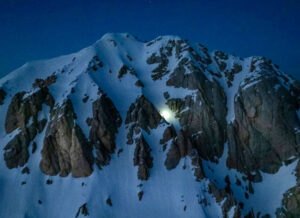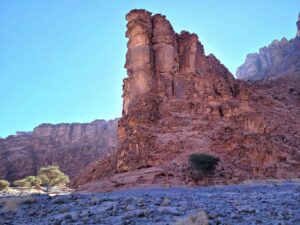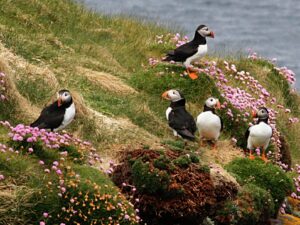Although each sailing route has its own nuances, planning any big ocean voyage has a lot of overlap. Here, a veteran mariner details how she and her husband planned a 10,000km, five-month journey from Thailand to Australia.
In 2017, a friend asked us to deliver their sailboat from Phuket, Thailand to Hamilton Island, Australia. A grand adventure sailing through the tropics, across warm, clear water, lazing on white, sandy beaches, and eating exotic food.

A map torn from an old school atlas gave an overview of the route.
The black line on the map above, torn from an old school atlas, took us down the Malacca Straits, across the equator, past Borneo, and over the Java Sea to Bali. Heading east, we would sail past islands with evocative names such as Sumbawa and Tanimbar, and see creatures such as tarsiers and Komodo dragons. We would cross the Wallace Line, sail through the fabled Spice Islands, and traverse the infamous Torres Strait.
How to get started
But how exactly does one sail from Thailand to Australia, passing through five countries and across nine seas? Can you just sail through? Or are there immigration requirements? What time of year gives the best weather? Is it safe? What about pirates? Or if you get sick or have an accident? What if something breaks? What about food? Fuel? How do you even begin to plan such a voyage?
Initially, we looked at when would be the best time to make the voyage. Using a sailboat, you want wind, just enough but not too much, blowing in the right direction. You also need to consider currents. It is preferable to sail with a current, and competing winds and currents can result in very rough seas.
Using pilot charts, we studied the winds and the currents and determined that it was best to leave Thailand before the end of the northeast monsoon, which lasts from October to May. We hoped to be south of the Sumatra Squalls band by April.

Pilot Chart of the Indian Ocean downloaded from www.passageweather.com
As we planned our route further east and into the Trade Wind belt, we discovered a challenge. The trade winds are strong, steady winds that blow consistently from the east from April to November. The trades do switch direction prior to and during the cyclone season, so a west-to-east passage is best done during October and November. While there are safe ways to sail at this time of year, most insurance companies balk at the idea. We decided that we would go earlier and look for local weather windows. But we would likely have to buck the trade winds for about 1,000 nautical miles.

The original rough plan, with references to The Cruising Guide to Indonesia.
A plan takes shape
We then worked up a rough plan. We consulted charts, cruising guides, cruiser forums, and spoke to sailors who had done the passage. Everyone agreed that the way to do it was in the opposite direction, from east to west, but we didn’t have that option. We figured out where we might anchor and determined how far it was between each anchorage.
In our calculations, we used an average speed of 5 knots (that is, 5 nautical miles per hour or 9.2kph). It was on the slow side for the boat but built in some contingency time. We estimated how long each section would take, then plotted this against calendar days. This was not so much to commit to dates but to give us an indication of where we would be each month so we could check expected weather/current conditions.

An invaluable reference book for the route.

Details of anchorages in the Cruising Guide –- important information for poorly chartered waters.
Once we had completed our high-level plan, we had to consider the bureaucracy. How do we enter and leave each country? What are the immigration requirements for the crew? Are visas needed? Are there biosecurity considerations?
There are a number of cruiser forums where you can ask advice from those who have been before. There is a marvelous website called Noonsite, founded by legendary yachtsman and author Jimmy Cornell. It helps sailors navigate the bureaucracy of global travel by boat. The site gives information on everything from formalities to fuel and marine services. It provides advice about each country and helpful links to immigration departments and border forces.
Using Noonsite and other resources such as Cruiser Forum and Cruiser Log, and talking to fellow sailors, we worked through the formalities of each country for a dual Canadian-Australian citizen, a Canadian citizen, and an Australian-flagged sailboat. Each country has its own requirements.
We needed to carry a mound of paperwork: proof of ownership, registration, insurance for the boat, passports, visas, and vaccination records. We prepared an inventory of items such as radios, EPIRBs, and electronic navigation equipment that had to be declared on entry.
In Langkawi, Malaysia, we could pull into the marina and simply walk down to the Port, where immigration, customs, and the Harbor Master had adjacent offices. Here, we could complete the paperwork within an hour. Other places required a taxi and a full day to run around the different offices.
In Singapore, you are not even allowed to land until you’ve completed all the formalities. The authorities require you to radio in from a predetermined latitude and longitude, where they will meet you. They use a fishing net to collect all the paperwork and process it as they bob alongside. I wonder how many bundles of paperwork have ended up at the bottom of the bay!
Packing
Now that we understood roughly how our voyage would look and the formalities to allow smooth passage, we started to consider fuel and food. Although we were on a sailboat, we needed diesel to run the engine to charge batteries, to assist us in maneuvering in and out of harbors, and when pushing against the trade winds.
Knowing where fuel is available is vital. Noonsite and cruising guides can assist with this. In Thailand, Malaysia, Singapore, and Australia, there were marinas and fuel docks scattered along our route. In Indonesia, fuel docks are few and far between. We needed to be prepared with jerry cans and hire taxis to ferry fuel to our dinghy.

Collecting jerry cans for use when a fuel dock was not available.
Food is not such a challenge, but the foods available vary significantly. Don’t expect Western-style supermarkets on tiny islands in Southern Maluku. With limited fridge and freezer space, our provisions included dry goods such as milk powder, rice, lentils, and tinned goods such as tuna, tomatoes, and beans. We planned major provisioning stops in Thailand and Singapore, where there is access to large supermarkets. We bought fresh eggs, vegetables, and fish from local markets.

Market in Krabi, Thailand.

Not all food is sold the way Westerners are used to.
As the boat had a desalinator, which creates fresh drinking water from seawater, we did not need to consider access to water as part of our plan. We had ample water storage to make the next port in case the desalinator stopped functioning.
Assessing risk
We then worked through the risks. For dangers associated with the boat sinking, or a man overboard (MOB), we carried a life raft and undertook training. We completed drills in MOB and Survival and Safety at Sea. We implemented protocols as we were sailing double-handed — a yachting term for just the two of us. For security, we wore personal flotation devices almost all the time. Finally, we always clipped to the boat in rough weather, at night, or when alone in the cockpit.
We also had signals to alert the other person when all hands on deck was required: a whistle when under sail and a change of engine revs when motoring.
Weather is one of the major risks. While you can time a voyage to take advantage of fair winds and following seas, localized weather systems and squalls can occur anywhere. To monitor the local weather, we used local bureau of meteorology websites, radio broadcasts, and weather apps. When traversing the Torres Strait, we employed the services of a weather router.
Weather routing is a service that gives you the best route for a particular passage based on weather, tide, currents, etc. In our case, our weather router (using a number of different software models) gave us the best route for bashing into the trades. We headed south into the Gulf of Carpentaria for about 100nm before we turned toward Thursday Island to give us a better angle. We reported to her the weather and sea conditions we were experiencing and she would determine which of her models was the most accurate. She then gave us a bearing to sail to.

A GRIB File downloaded from www.passageweather.com. These are small files and great with limited internet.

A screenshot from the app Windy.com, shows wind predictions. It is a fabulous resource but requires good internet. Windy also predicts current, precipitation, wave height, and swell.
Another risk is illness or accident. We carried a comprehensive first aid kit and both of us have first aid training. We were also fully vaccinated against illnesses such as cholera, tetanus, and hepatitis. As we were within helicopter range (for emergency evacuation, if necessary) during this trip, we did not feel the need to carry opioids. But we had several types of antibiotics, each with very specific instructions on their use. We carried steri-strips but not sutures, as neither of us was trained. On future trips, we will take this training, since the worst injury we had was a deep gash that required stitches.

Sean Collins after being hit by a rogue halyard. A minor wound, but a great deal of blood.
A risk, specific to this region, is hitting a Fish-Attracting Device (FAD) or a fishing net. FADs are floating wooden structures that provide shade and attract fish. They do not show up on the radar and are solid enough to do significant damage. When sailing close to the coast, we kept watch for these and had a strong spotlight that we shone periodically at night.

A Fish-Attracting Device off Flores, Indonesia.
Fishing nets are also problematic. Often, they stretch for a nautical mile or so, completely unmarked and unlit. These have the potential to destroy a rudder or pull out the propeller shaft, disabling or even sinking a boat. We were wary of small, stationary craft. We were very fortunate but have heard horror stories of others who were not.
Running aground is always a risk, particularly in areas where the charts are not accurate. We carried a full set of small-scale charts and relied on electronic charts for detail.
In Indonesia, though, the charts are notoriously inaccurate. Here, we resorted to Google Maps for entering anchorages. Although this did not show depth, it did indicate where the deeper water was. As we entered an anchorage, if the water started to get shallow, Google Maps could show which direction led to deeper water.

A Google Maps screenshot of a proposed anchorage. You can see the outline of the reef.
Pirates and dangerous critters
What of pirates? Pirates are a real risk in certain parts of the world. There are places we would choose not to sail because of this. The Malacca Straits were once notorious for pirates, but thanks to a multinational task force, piracy of small pleasure craft is now virtually unheard of.
While caution is always required, common sense also comes into play. In Indonesia, pale skin is a status symbol. It indicates that you work indoors rather than outside as a laborer. So fishermen wear balaclavas to keep off the sun. It is very disconcerting to watch a fishing boat change course and come charging in your direction with half a dozen gesticulating, balaclava’d people aboard.
“Oh my goodness, it’s pirates,” is the first thing that springs to mind. Yet it’s simply a boatload of curious fishermen, who want to take selfies with you. There are a number of resources to research piracy around the world, including Noonsite.
The waters where you are sailing may have other inherent risks. Are there crocodiles, Irukandji jellyfish, sharks, or sea snakes? Understanding the water through which you are sailing helps manage the risks associated with being stung, bitten, or mauled. It also dictates what you carry in your first aid kit. Vinegar is very effective against some jellyfish stings, but it is worth forgoing swimming in areas where crocodiles live.
Staying in touch and above water
Out at sea, cell phone coverage is not always available. We used Iridium Go to connect us. Iridium works everywhere but has very slow data transmission. We could send and receive emails and make voice calls but not download large graphic files. We also bought local SIM cards when in cell phone range. Technology evolves rapidly, and satellite internet and telephone are getting cheaper and more readily available.
One communication tool that people underestimate is Google Translate. Arriving on small islands where residents spoke very limited English, we were able to communicate our needs –- diesel (solar), food (makanan), market (pasar), and resolve the big puzzle: How did you get here?

‘We are traveling by boat’ in Bahasa Indonesia. Giving context is very helpful when searching for diesel.
And we considered maintenance. We brought enough engine oil for the journey from Singapore to Australia. We were uncertain about the availability of spare parts so we carried belts, filters, impellers, O-rings, and everything we needed for regular maintenance.
This included onboard tools for whipping, plugging, minor fiberglass repairs, tools that enabled us to cut away a failed rig, and reading glasses so we could actually read the instructions! We also undertook training to ensure that we had the skills to carry out all the regular maintenance ourselves and carried a full set of manuals for all the equipment.

Equipment manuals.

The author up the mast, replacing the radar reflector.
With the planning done and last-minute chores complete, we left Phuket, Thailand on Feb. 23, 2017, and arrived on Hamilton Island in Australia on July 27, 2017. We traveled through five countries and sailed across nine seas, a distance of 9,830km.






